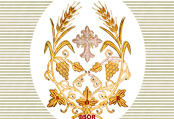
 |
|
||
| The Syriac Bible |
|
|
The Syrian Orthodox Church believes that the Holy Bible, which comprises of the Old Testament and the New Testament, is the divine word of God. Its Fathers labored in translating the Holy Scriptures into Syriac since the very dawn of Christianity. These Syriac translations of the Bible are the oldest and most ancient in any language. Further, the Syriac New Testament is quite unique for it presents the teachings of our Lord in an Aramaic dialect (Syriac) which is akin and would have been mutually comprehensible with the Palestinian dialect of Aramaic in which Christ taught. Since the translation of the Bible into Syriac started as early as the first century, the Syriac version preserves the very ancient renditions of the original texts. In fact, the Syriac Church Fathers produced a number of translations of the Bible and revisions of these translations from the original languages of the Bible. The words of Christ were first transmitted in his native language, the Palestinian dialect of Aramaic, either orally or in a written form. It is from this Aramaic tradition that the Greek Gospels were derived. The Syriac New Testament as we know it today is an early translation of the Greek text back into Syriac, the Aramaic dialect of Edessa (Modern Urfa in Southeast Turkey). The Syriac Old Testament is a translation from the original Hebrew and Aramaic (a different Aramaic dialect from Syriac which is known by the name 'Biblical Aramaic'). The close similarities between the Palestinian dialect of Aramaic spoken by Christ and Syriac offer us a unique understanding of some of the Biblical readings. For example, in the English King James version of the Bible we read in Matthew 5:18 "Till heaven and earth pass, one jot or one tittle shall in no wise pass from the law, till all be fulfilled." What could jot mean? The Syriac Bible uses the word yod for jot in this verse. This word is the name of the tenth letter of the Aramaic alphabet, shown below in the Syriac Estrangelo script (read from right-to-left; yod is shown in color):
Note that yod is the smallest letter in size. The above verse means that not even the smallest of the letters shall pass from the law. This is rendered in the English New Revised Version as "not one letter." Another interesting reading appears in the Lord's prayer. The King James reads "and forgive us our debts, as we forgive our debtors" (Matthew 6:12). The Syriac version reads "and forgive us our debts, as we also have forgiven our debtors." This implies that we must first forgive our debtors before asking forgiveness from God. The English New Revised Version agrees with the Syriac in this verse! In many instances the Syriac language offers interesting interpretations of Biblical verses. An understanding of Syriac homonyms, for example, help us clarify the reading in Matthew 19:25 (also Mark 10:25 and Luke 128:25), when Jesus tells us how much easier it is for a camel to go through the eye of a needle than for a rich person to enter the kingdom of God. The Syriac word corresponding to camel is gamlo which means 'camel.' However, gamlo has other meanings as well, one of which is given by the Syriac lexicographer Bar Bahlul (10th century) in his Syriac dictionary: "gamlo is a thick rope which is used to bind ships." Considering that Jesus was speaking to fishermen, this meaning of gamlo seems more appropriate. The Syriac Fathers studied the Bible in a critical and scientific manner, though regarding it at the same time as a divine text. Witness to this are the numerous translations and revisions of translations and the massive body of commentaries that they have produced. Some of these translations were lost until they were discovered by Western scholars in the past 150 years. Many old Syriac manuscripts of the Biblical texts survive and can be found in the major museums and libraries of the world and of course in the ancient Syriac libraries of the Middle East as well. The most famous manuscript is that of the Gospels which is written by a certain Rabbula, hence known as the Rabbula Gospels. It is famous for its decorative calligraphy and miniatures which are excellent representations of Syriac art. The first printed edition of the Bible was an edition of the New Testament which was printed in 1555, soon after the advent of printing. It was published by Johann Widmanstetter, with the assistance of a Syriac Orthodox priest, Moses of Mardin. Moses was sent by the Patriarch of Antioch to meet with the Pope of Rome and served as a teacher of Syriac in Europe. The Syriac Bible is available today from the United Bible Societies. The Peshitta Institute at Leiden is preparing a new annotated English translation of the Peshitta Old Testament (NEATSB, or The New English Annotated Translation of the Syriac Bible). |
| Copyright © Syriac Orthodox Resources. All Rights Reserved. |
|
Author: George Kiraz, Ph.D. Last Updated: Feb 25, 2001 |